The Betelgeuse star, currently in the final phase of its existence, is a red supergiant. There is a possibility that it will undergo a spectacular supernova event in the near future.
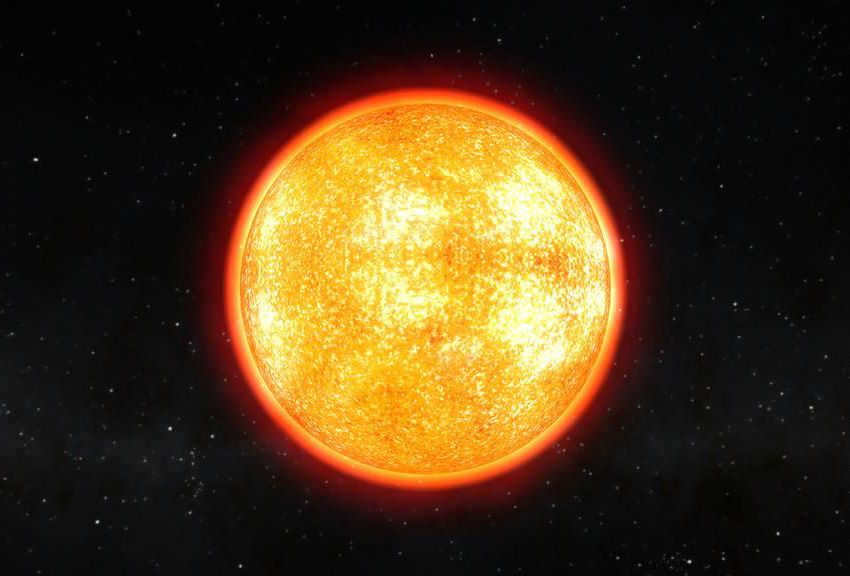
The Origin of the Name
The original name of this star in Arabic was “Yad-al Jawza,” meaning “twin hand.”
However, during the medieval era, a scribe or translator mistakenly replaced the hieroglyph that represented the sound “y” with one that represented the sound “b” when copying ancient scientific works on astronomy and descriptions of constellations. As a result, the star came to be known as “Beteljuz,” meaning “house of twins.”
In ancient Persia, the star was referred to as Bashn, the Copts called it Claria, and the ancient Hindus named it Ardra.
Main features of the star
Betelgeuse, located in the Orion constellation, is the largest star in terms of size. It is considered the ninth brightest star in the visible Universe. This particular star is classified as a variable star, meaning that its luminosity fluctuates over a span of several Earth years. Its magnitude ranges from 1.2 to 0.4 (alternatively, some sources indicate a range of 1.9 or 1.4 to 0.2) stellar magnitude.
Betelgeuse’s dimensions
The size of Betelgeuse fluctuates due to random pulsations, with its absolute magnitude ranging from -5.27 to -6.27. Additionally, the star’s radius varies from 4.6 to 5.5 astronomical units (a.u.). At times, Betelgeuse displays asymmetry, presenting a small but noticeable bulge when observed through powerful telescopes.
This phenomenon may be attributed to periodic ejections of gas from its surface, causing the supergiant to gradually lose mass. Some scientists have also proposed the existence of a companion star within this celestial body.
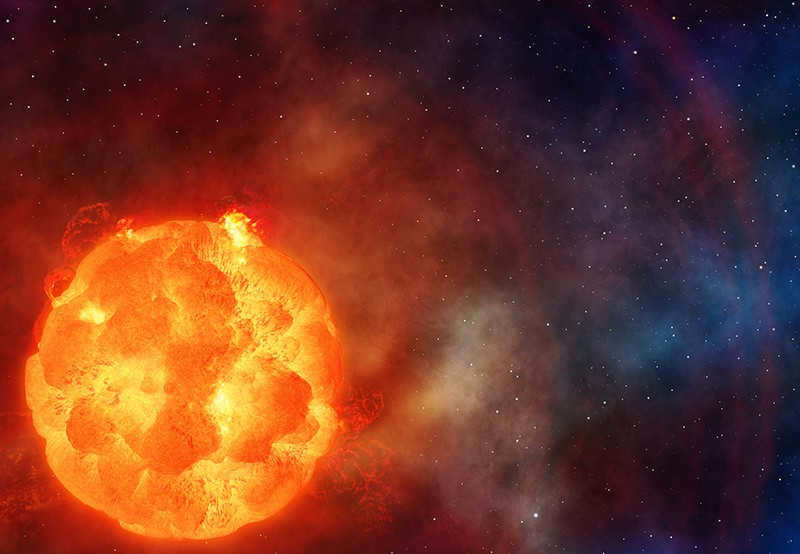
In addition to its mass, Betelgeuse also experiences changes in its size: research has shown that it has decreased by 15% over a 15-20 year period since 1993.
There are three possible explanations for this phenomenon:
- The apparent change in Betelgeuse’s radius could be attributed to variations in brightness on its surface.
- Large stars like Betelgeuse are inherently nonspherical and may exhibit bulges.
- We are uncertain about the true diameter of Orion’s Alpha, and it is possible that its outer shell consists of dense gas that moves, creating the illusion of fluctuations in Betelgeuse’s size.
The radius of the star is 1200 times larger than that of our sun (according to other sources, it is 950 times larger), and its mass is 13-14 times heavier (according to other data, it is 17-20 times heavier). If Betelgeuse were to replace the Sun, it would extend to the distance from the center of the solar system to Jupiter at its maximum expansion, and to the orbit of Mars at its maximum contraction.
In terms of temperature, the star is 1.85 times cooler than the Sun, but it is 100,000 times brighter and approximately 500 times younger – Betelgeuse is estimated to be around 10 million years old.
The temperature
The surface of the supergiant has temperatures that reach 3000 degrees Kelvin. This temperature is relatively low, and it is the reason for the celestial body’s reddish color.
Distance
The distance from us to Betelgeuse is 643 light-years. This is the most recent information obtained after refining the object’s coordinates. In 1997, the distance was estimated to be 430 light-years, and in 2007 it was revised to 520 light-years. The exact distance has yet to be determined.
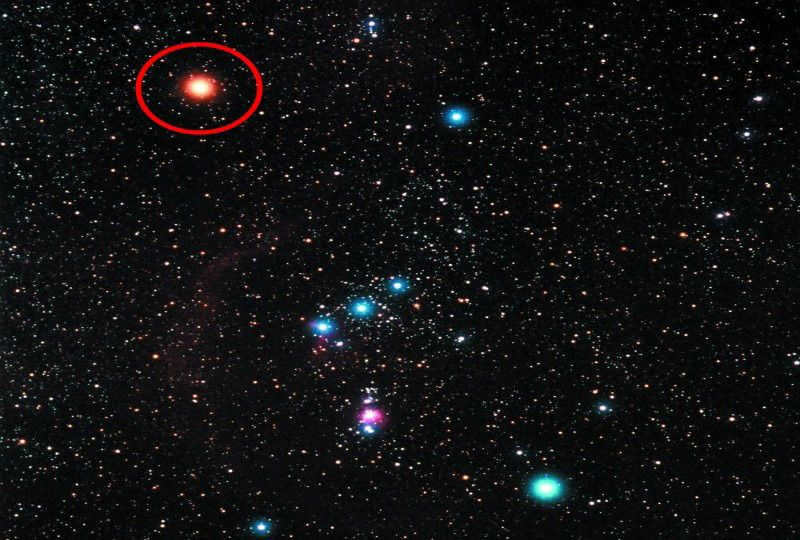
Locating the star in the night sky
Betelgeuse can be easily spotted from almost anywhere on Earth, and its brightness allows for visibility even in heavily urbanized areas. Throughout the year, the constellation Orion moves across the celestial sphere. In January, for observers in the Northern Hemisphere, it rises in the eastern part of the sky shortly after sunset. By February, it will be found near the center of the sky, and by mid-March, it will have moved to the southern part of the sky. Conversely, for those in the Southern Hemisphere, its position will shift in the opposite direction: west-center-north.
Identifying this supergiant is a simple task as it stands out among its surrounding stars due to its impressive brightness and distinctive reddish hue. If you are familiar with the constellation Orion on a star chart, locating Betelgeuse becomes even easier. In terms of its position within the constellation, Betelgeuse is traditionally recognized as the left shoulder of the hunter (with the right shoulder being occupied by the blue-white star Bellatrix, the third largest in this constellation).
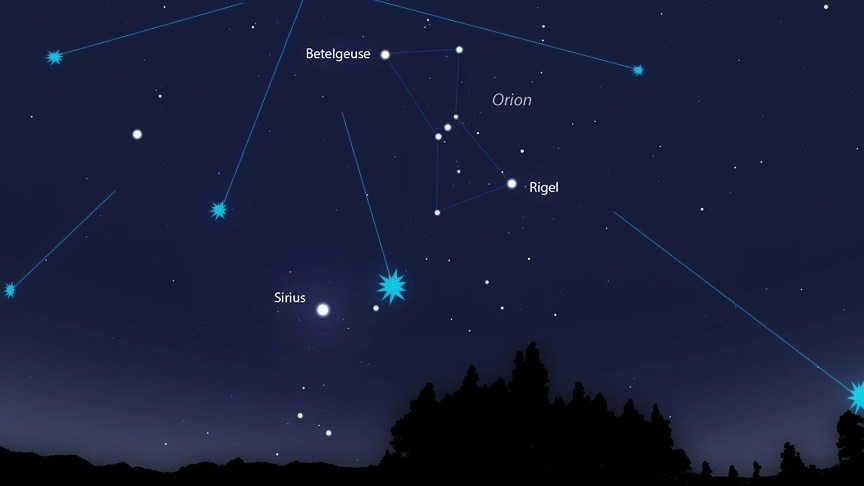
Betelgeuse is a component of the Great Winter Triangle. If you observe the asterism from the Northern Hemisphere of Earth, Betelgeuse will be positioned at its upper right point (the brightest point of the triangle, Sirius, will be located at its lower apex).
Fun fact: during the summer solstice in the Northern Hemisphere, Betelgeuse can only be observed in a telescope during daylight hours.
The supergiant is currently in its final phase of existence, undergoing the combustion of its remaining carbon reserves within its core. Once this process is complete, the star will transition into a supernova. The exact timing of this event is uncertain, with the potential for it to occur within a span of several thousand years or possibly even within a few decades. When the supernova does occur, it will unleash an immense amount of energy, equivalent to the cumulative energy output of the Sun throughout its entire lifespan.
Due to the immense distance between our planet and Orion’s Alpha, the explosion and supernova formation will have no impact on Earth. However, there may still be some observable consequences.
- The aurora borealis will be significantly brighter.
- There will be a slight decrease in temperature.
- There may be minor disruptions in the functioning of mobile communications and navigation satellites.
Even without the use of binoculars, Earth observers will be able to see the glow, which will persist for at least two weeks. It will appear as a second moon in our sky, visible not only at night but also during the day.
There exists an alternative hypothesis which posits that Betelgeuse, presently undergoing mass loss, will ultimately transform into a white dwarf within the Milky Way. It is also plausible that the star has already completed its lifecycle, yet the resulting explosion will be observable on Earth after a minimum of 500 years.
The star Betelgeuse, belonging to the red supergiant category, is situated within the fixed stars. It is currently in the final stages of its existence. In the foreseeable future, this star will undergo a cataclysmic supernova event. Scientists speculate that, for a span of approximately two weeks, it will serve as a substitute for the Moon, occupying a position near the Earth in the sky due to its proximity to the Sun.
The red giant Betelgeuse and its counterpart, Rigel, in the constellation of Orion.
Within the constellation of Orion, two remarkable supergiants can be found: Betelgeuse, a magnificent red supergiant, and Rigel, an awe-inspiring blue supergiant.
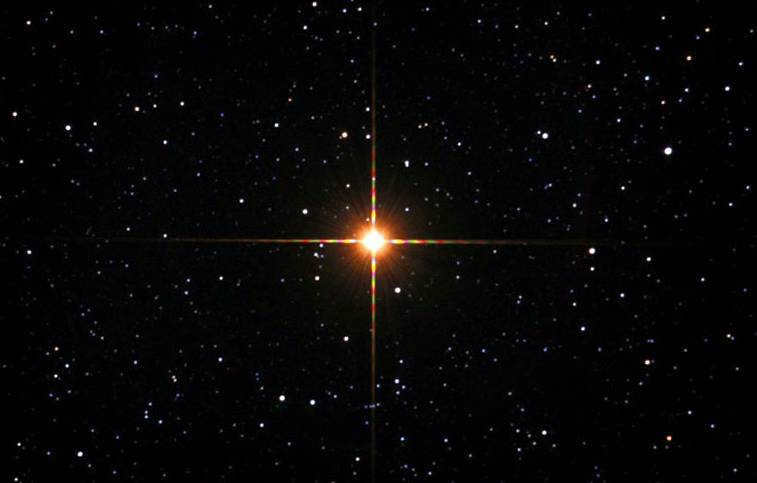
Orion’s Alpha is not constant. Its brightness in the night sky can vary from 0.4 to 1.4 magnitudes. This means that Betelgeuse and Rigel appear to be in a constant competition for brightness. Interestingly, there are times when Alpha Orion can actually surpass Rigel in luminosity.
The red supergiant was originally meant to have a different name. However, due to a mistake that occurred, the red giant ended up with its current name.
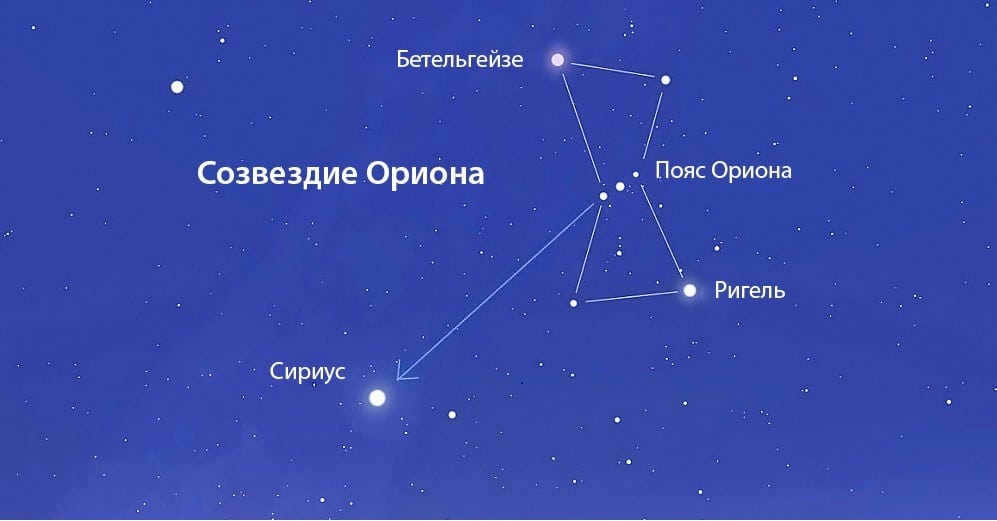
Origin of the Name
The name of the red giant Orion originated from the Arab countries. In Arabic, the giant was referred to as “Yad-al Jawza”, which translates to “the hand of the twin”. During the Middle Ages, the Arabic character that sounded like “y” was mistakenly confused with the character “b”.
As a result, the incorrect interpretation of “Beteljuz” was adopted. It was translated as “house of twins”. In Arabic astronomy, the constellation of Orion is known as “Gemini”.
In addition to its original name, the red giant is also known by other names:
- Bashn (Persian for “hand”);
- Claria (Coptic for “bandage”);
- Ad-Dira (from Arabic “hand”);
- Ardra (Hindi language).
Ways to observe in the nighttime sky
Betelgeuse is visible in the nighttime sky of the Northern Hemisphere of Earth.
This red supergiant is situated in the Orion constellation, making it a prominent feature of the winter sky. It can even be spotted in urban areas during the month of February.
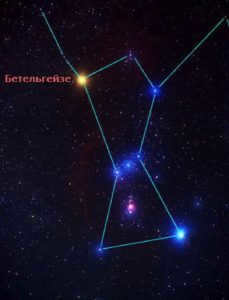
This constellation is known as a winter constellation because it only occupies a position on the southern side of the sky during the cold season. Astronomers refer to this as its culmination. Any celestial body that is situated on the southern side of the sky is easily observable for amateur astronomers.
It becomes visible in January in the eastern part of the sky shortly after the Sun sets. By March 10th, it can already be seen in the southern part of the sky in the evening. During this time of year, Betelgeuse can be spotted from any location on Earth.
Important note! In Sydney, Cape Town, and Buenos Aires, the red supergiant rises to a height of 49 degrees in the sky.
Now, let’s discuss the specific location of this star.
Main Characteristics
When it comes to brightness, the red supergiant holds the 9th position in the night sky. Its luminosity fluctuates between 0.2 and 1.9 stellar magnitudes over a span of 2070 days. It falls into the spectral class m1-2 la lab.
Star Size
This star has a radius equivalent to 600 times the diameter of the Sun. It is 1400 times larger than the Sun. Its mass is equal to 20 solar masses, and its volume is 300 million times that of the Earth.
The star’s atmosphere is thin and its density is much lower than that of the Sun. It has an angular diameter of 0.050 arc seconds, which varies depending on the giant’s luminosity.
Astronomers utilized a spatial infrared interferometer to measure the star’s radius. They also calculated its rotation period, which amounts to 18 years.
It is of great importance that in 1920, astronomers were able to measure the angular diameter of Beteljuz, making it the first planet after the Sun to have this measurement recorded.
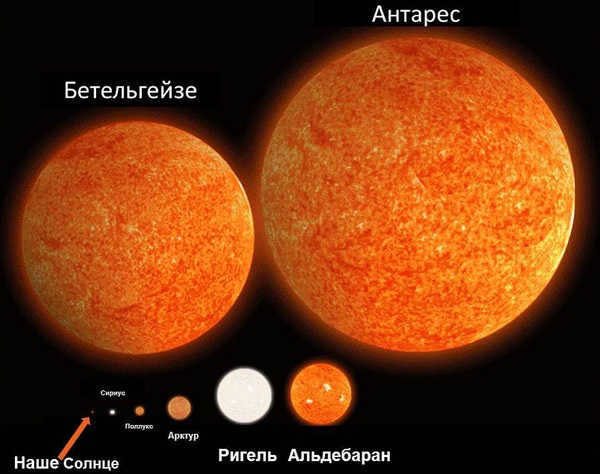
Temperature
The red supergiant has a temperature of 3,000 degrees Kelvin (2,726.8 Celsius), which is significantly cooler compared to the Sun. In contrast, the Sun has a temperature of 5547 degrees Kelvin (5273.9 degrees Celsius). The star’s reddish hue is attributed to its lower temperature.
Distance
The red supergiant is located 643 light-years away from our solar system. This is a considerable distance.
When this red supergiant eventually explodes and transforms into a supernova, as astronomers predict, the resulting waves that reach Earth will not have any impact on the planet’s ecosystems.
Detailed information about this star can be found in the following table:
05h 55m 10.3053s (right ascension), + 07° 24′ 25.426″ (declination).
The radius of Betelgeuse is not constant. It undergoes changes in shape and has an asymmetrical shell with a slight bulge. This provides us with two pieces of information:
- The star loses mass every year as jets of gas erupt from its surface.
- There is a companion within Betelgeuse that causes it to behave erratically.
Scientists who have been observing the star since 1993 have noticed that its size has decreased by 15% while its brightness has remained unchanged.
Approximately five shells have been discovered surrounding this giant star. Additionally, in the ninth year of the twenty-first century, researchers detected another emission measuring 30 astronomical units.
In 2012, astronomers made a prediction that Betelgeuse could encounter interstellar dust in twelve thousand years. Furthermore, a year prior to that, one scientist listed it as a potential trigger for catastrophes in 2012.
Caution. Currently, scientists are unable to ascertain the regularity of the fluctuation in the star’s diameter due to its pulsating nature.
Scientists attribute the decrease in size to the following factors:
- Variations in brightness across different regions of the supergiant’s surface. This can result in a decrease in the star’s luminosity on one side and an increase on the other. On Earth, this can be likened to a change in diameter;
- There is speculation that massive stars are not perfectly spherical, so Betelgeuse exhibits a bulge;
- A third hypothesis posits that what astronomers observe as the star’s diameter may actually be a layer of dense gas. The movements of this gas layer create the illusion of Alpha Orionis changing in size.
Attention! There is a gas nebula surrounding Alpha Orion, which went unnoticed by astronomers for a significant period of time due to the intense brightness emitted by Betelgeuse.
Furthermore, it is worth noting that Betelgeuse forms a part of the winter triangle, which consists of Procyon, Sirius, and this massive supergiant.
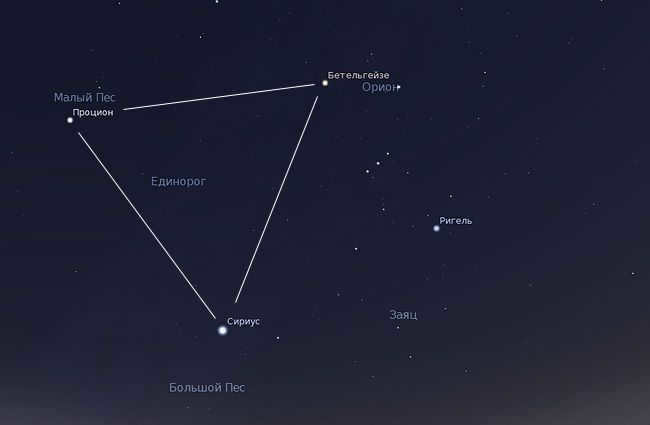
In various cultures around the world
The star Betelgeuse has been referred to by different names in various nations across the globe. Each nationality has its own customs and legends passed down from ancestors about the origin of this celestial body.
For instance, in Brazil, it is known as Gilcavai, which is derived from the hero whose leg was torn off by his wife.
In Australia, it is called “owl eyes” as the two stars on Orion’s shoulders resemble the eyes of these nocturnal birds, according to Australian beliefs.
In South Africa, it is referred to as the lion that hunts three zebras.
In literature and films.
The red supergiant is referenced in various works, poems, and movies by both Russian and foreign authors. For instance, in the renowned film “Planet of the Apes,” the planet Sorora orbits around this star. It is from Sorora that the intelligent primates arrived on Earth.
One of the protagonists in the popular movie “Hitchhiker’s Guide to the Galaxy” hails from a planet whose sun is Betelgeuse.
The Danish author Niels Nielsen also makes mention of this star in his literary works. In his novel “A Planet for Sale,” he depicts how “planet hunters” steal a small satellite from Alpha Orion and transport it to Earth.
As far back as 1956, Varlam Shalamov included a reference to this star in his Atomic Poem.
The famous novel “The Sirens of Titan” by Kurt Vonnegut also references the star. In this novel, the protagonist exists as a spiral wave pulsing around the Sun and Betelgeuse.
Roger Zelazny wrote a novel called “The Light of the Sullen” which takes place on one of the planets orbiting the red giant star right before it undergoes a supernova explosion.
Arseny Tarkovsky mentions Betelgeuse in his poem “Star Catalog” written in 1998.
References to the actor from Beetlejuice can be found in the film Blade Runner. When the character Roy Batty dies, he describes it as Orion’s shoulder, saying, “I witnessed something that you would not believe. Burning warships near the entrance to Orion’s shoulder. I have seen C-rays… flickering in the darkness by the gates of Tannhäuser. And all these moments will disappear over time like tears in the rain. It’s time to die.”
One of the writers is known as See Betelgeuse. He has written a poem dedicated to Alpha Orion.
The Ukrainian rock band Tabula Rasa has a song dedicated to the red giant called “Rendezvous on Betelgeuse”.
Comparison with the Sun
When compared to the Sun, Betelgeuse is significantly larger in size.
If Betelgeuse were placed in the solar system, it would extend all the way to Jupiter. As its diameter decreases, it would reach the orbit of Mars.
Betelgeuse is 100,000 times more luminous than Earth and has an age of 10 billion years, while the Sun is only around 5 billion years old.
Scientists are increasingly puzzled by Betelgeuse’s behavior, as it exhibits similar characteristics to the Sun. It has localized areas with higher temperatures compared to its surrounding surface, as well as areas with lower temperatures.
Despite the fact that the Sun has a spherical shape while the red supergiant Betelgeuse has a potato-like shape, this phenomenon continues to perplex scientists.
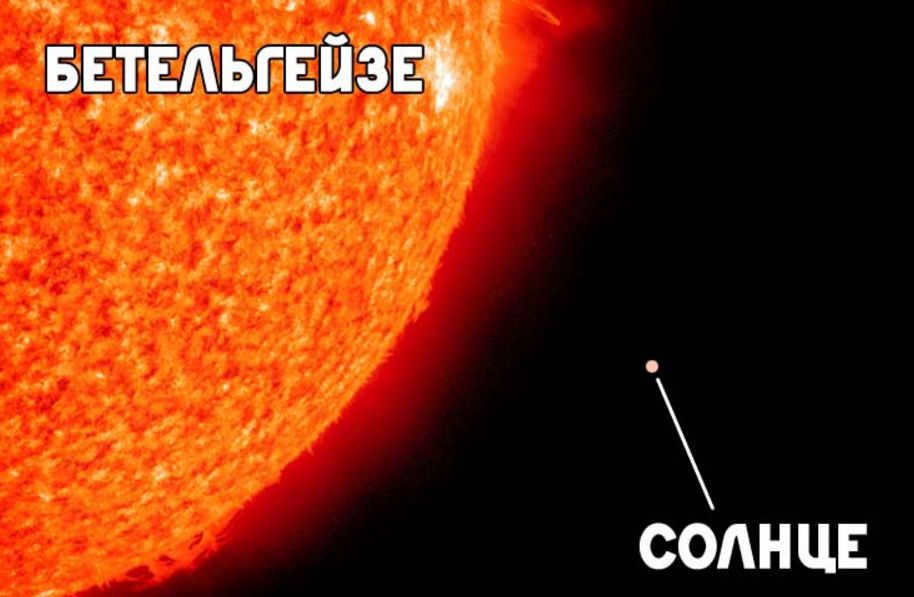
Betelgeuse’s Impending Explosion
The red giant star is currently in the final stage of carbon combustion. By understanding the internal processes occurring within the star, scientists can predict what lies ahead for Betelgeuse. For instance, a rapid explosion would result in the creation of elements like iron, nickel, and gold. Conversely, a slower explosion would produce gases such as carbon, oxygen, and barium.
Researchers believe that the red supergiant is on the verge of becoming a supernova. In just a few thousand years, or possibly even sooner, Betelgeuse will undergo a cataclysmic explosion, dissipating its energy into the surrounding space. This explosion will release an amount of energy equivalent to that which the Sun emits throughout its entire existence.
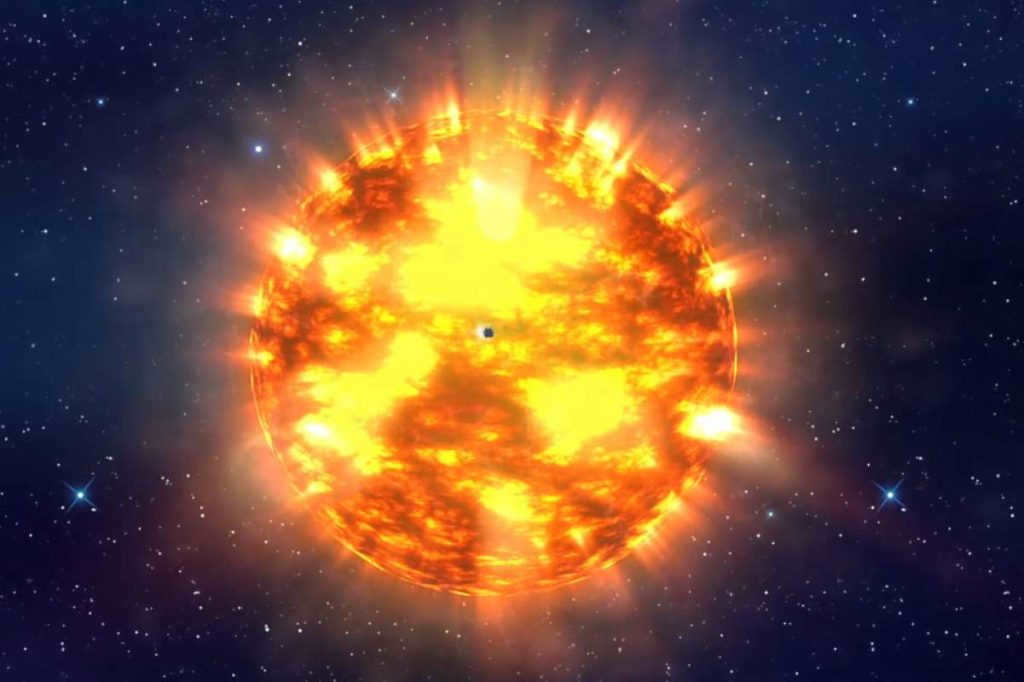
The Earth is situated in a solar system that is distant from the Red Giant, so there is no anticipation of any complications from its explosion. However, its luminosity will be detectable from Earth. Individuals will be able to observe this explosion with the naked eye.
The burst will endure in the sky for an extended period in the likeness of an additional moon during the nighttime. After a few centuries, a black dwarf or neutrino star will develop from the exploded red giant, accompanied by the formation of a new nebula.
Primarily, the quantity of energy released from Betelgeuse has the potential to disrupt satellites, cell phones, and the Internet on our planet. The aurora borealis would become even more vivid.
Based on additional data, it is predicted that Betelgeuse will shed its outer layer and transform into a white dwarf, making this hypothesis highly plausible.
Currently, Betelgeuse is experiencing significant loss of its composition, resulting in the gradual formation of gas and dust clouds around the star.
Simultaneously, the presence of a bulge in the star is causing concern among scientists. It is speculated that this bulge may be another celestial object rather than a stream of particles being carried away from Orion’s alpha. If this hypothesis is confirmed, a collision between Betelgeuse and this object could be expected.
This bulge, currently referred to as a gas plume, is the result of Betelgeuse shedding its outer layer and creating a powerful flow of interstellar medium.
If an explosion were to occur, it would provide a spectacular display of a supernova event, with humans potentially being the first witnesses to such a rare occurrence in the Milky Way Galaxy, which only happens once every few thousand years.
The explosion of the star will only become visible to the future generations of humans in 500 years, as it is located at a great distance from our Solar System. The true light emitted by the star will only reach Earth in a few hundred years. This delay in visibility is due to the way energy spreads in the vacuum of space, where the light from distant sources takes longer to reach us.
Contemplating the celestial expanse, both common individuals and brilliant intellects have perpetually pondered the eternal. This remote and enigmatic realm, with its enigmas and discoveries, has always enticed, thus any tidings from this domain elicit a profound resonance. Recently, researchers have trained their gaze upon a celestial entity that is nearing the culmination of its existence. The photograph of the star Betelgeuse, with its perpetually shifting luminosity and radius, was scrutinized by scientists through divergent lenses, leading them to the deduction that an imminent explosion may be on the horizon. However, on a cosmic scale, how rapidly can such an eruption transpire, and should humanity harbor trepidation regarding the ensuing aftermath?
This particular star has captured the attention of astronomers due to its extraordinary nature. The occurrence of a supernova explosion and subsequent formation is an extremely rare event, with the last recorded instance in our galaxy taking place in 1604. Known as Kepler’s star, the dazzling burst of light from its explosion took an astounding 13 millennia to reach our planet after it was initially observed.
The etymology of the name
It is widely accepted that the prominent star Betelgeuse derived its name from a distortion of the Arabic phrase Yad al-Jawzah, which translates to “the hand of Gemini”. The connection between the constellations Gemini and Orion serves as the main framework for this interpretation. Some individuals also misinterpret this name as “the house of Gemini”, but such an understanding has no factual basis and is incorrect. In Arabic astronomy, the constellation Orion is occasionally referred to as Gemini, but this association is unrelated to the modern constellation of Gemini.
Astronomers today find certain aspects of the star to be highly intriguing. The size of Betelgeuse, for instance, was one of the earliest recognized features. Using an astronomical interferometer, scientists measured its angular diameter to be 0.047″. Subsequent systematic observations revealed that the star’s diameter is not constant. If calculations of the distance to this celestial body are accurate, its diameter ranges from 500 to 800 times that of the sun.
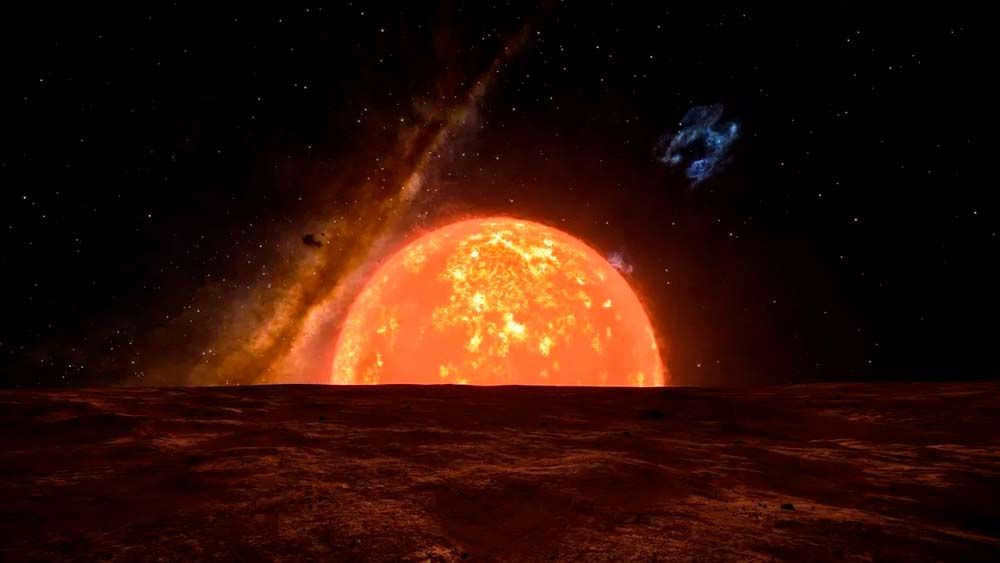

Not only is Betelgeuse’s diameter changing, but its color is also undergoing a transformation. Currently, it appears red and is in its final life stages. However, historical accounts from the 1st century BC by Chinese scholar Sima Qian mention a yellow star that bears striking similarities to Betelgeuse. Taking into account all the details of the description, scientists speculate that this star was indeed Betelgeuse. Just a century later, Ptolemy noted the red hue of the star, marking its transition into a red giant status.
One more fascinating fact is that the star is variable and its size is continuously fluctuating. Between 1993 and 2009, it diminished by 15%. Despite this, the brightness of the star has not shown significant changes. Scientists are still unable to provide an explanation for the varying size and are continuing to monitor the celestial object. It is plausible that the decrease in size is simply a misinterpretation of the collected data. As of now, the star continues to contract, suggesting that it may be nearing the end of its lifespan.
How to observe it in the nighttime atmosphere?
Although it is uncertain whether Betelgeuse will erupt in the near future, it is still worthwhile to be aware of its whereabouts. Familiarizing oneself with the star’s characteristics reveals that for those seeking to locate it in the sky, their attention should be directed towards the Orion constellation. Betelgeuse, being the most prominent star within the constellation, holds the alpha position.
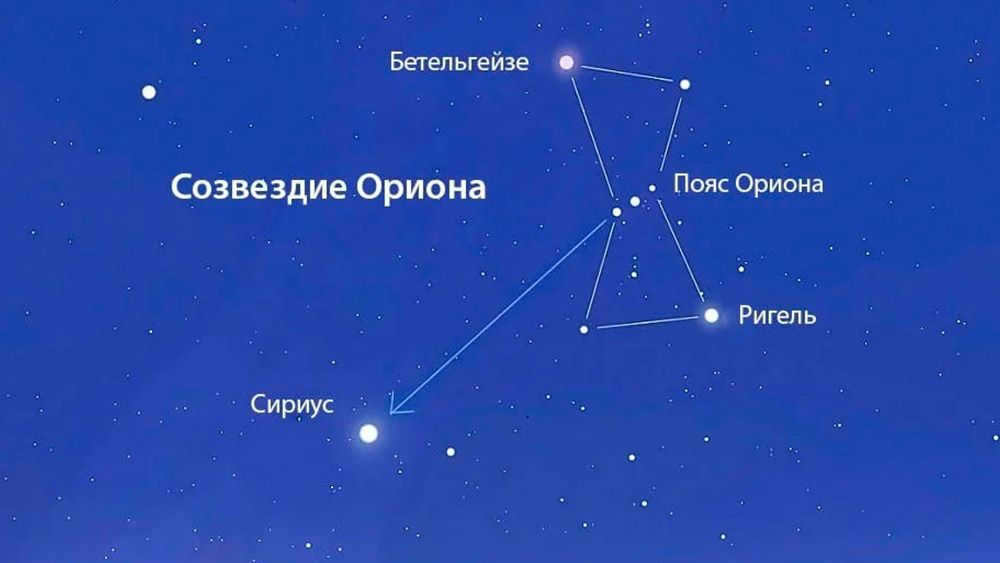
Comparison with the Sun
It is currently uncertain what exactly the star Betelgeuse looks like, as the diameter that is considered to be true may actually be a layer of dense molecular gas. This is mainly due to the lack of advanced technology and powerful telescopes that would allow for a closer examination of the star from Earth or the nearest satellite to Betelgeuse. Nevertheless, it is still possible to compare this red giant with our yellow dwarf.
Let’s start with the age. The brightest star of Orion, Betelgeuse, is still a young star, being only around 9 million years old, while our Sun has an impressive age of 4.5 billion years. Betelgeuse has a remarkable mass of approximately 17 times that of the Sun, and its luminosity is 80 to 105 times greater than that of our Sun. The exact radius of Betelgeuse is difficult to determine, but it is estimated to be around 760 times the radius of the Sun.
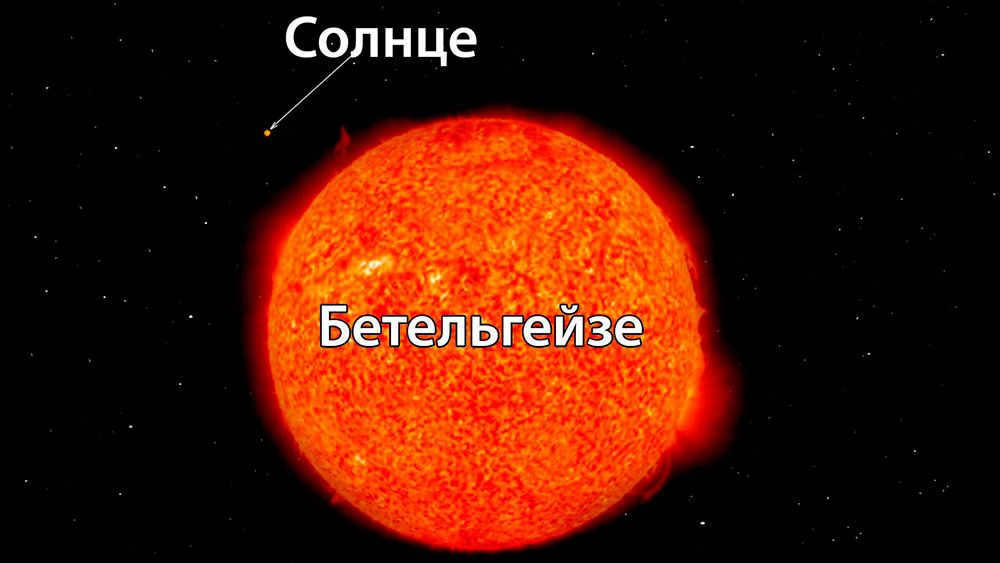

The fate of Betelgeuse
Most people are already familiar with the location of Betelgeuse in the night sky and its bleak future. All scientists concur that this red giant is destined for a rapid explosion, and it’s only a matter of time. Despite its relatively young age, Betelgeuse is rapidly depleting its fuel and resembles an engine that’s running on fumes, ready to stall at any moment.
Betelgeuse is a prime candidate for a supernova, evident from its celestial pulsations.
Within the next 100,000 years, an astronomical event of immense proportions is set to take place. However, this timeline may be subject to change due to potential errors in measurement and the star’s current unstable state. Over the past half-century of observations, it has never been observed to be as dim as it is now.
It is anticipated that just prior to Betelgeuse’s explosion, it will emit an incredibly bright light that will be visible even during daylight hours. This is due to its relatively close proximity to Earth in comparison to other celestial bodies. This intense luminosity will persist for approximately one week before gradually diminishing, leaving behind a cloud of cosmic dust. While the explosion will release a tremendous amount of energy and Betelgeuse is relatively nearby, there is no need for concern as it will have minimal impact on daily life.
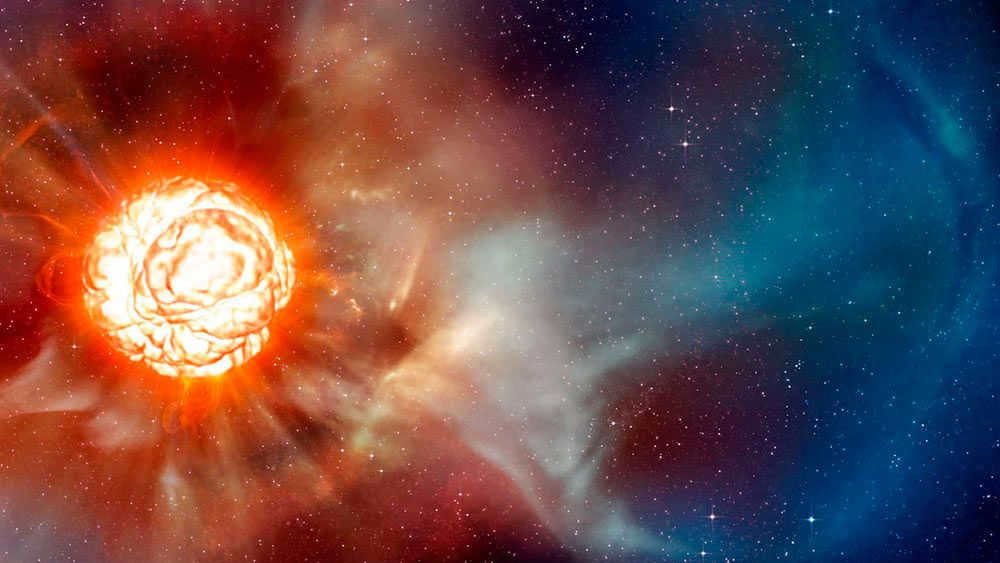

Curious information about the crimson giant
According to the most recent updated data, Betelgeuse is located approximately 643 light-years away from our planet Earth. Back in 2007, scientists estimated its distance to be at least 520 light years. However, the exact value remains unknown.
Despite the significant gap between Earth and Betelgeuse, some effects of its eventual explosion will still be perceivable by humans. These effects may include a slight drop in temperature, a more intense and vibrant display of the Northern Lights, and potential disruptions in satellite systems, including mobile communications.
Based on certain recent images of the celestial body Betelgeuse, a group of scientists have put forth a theory that the star has already undergone a cataclysmic explosion, yet the luminous burst resulting from this event will only become visible on our planet in approximately five centuries.
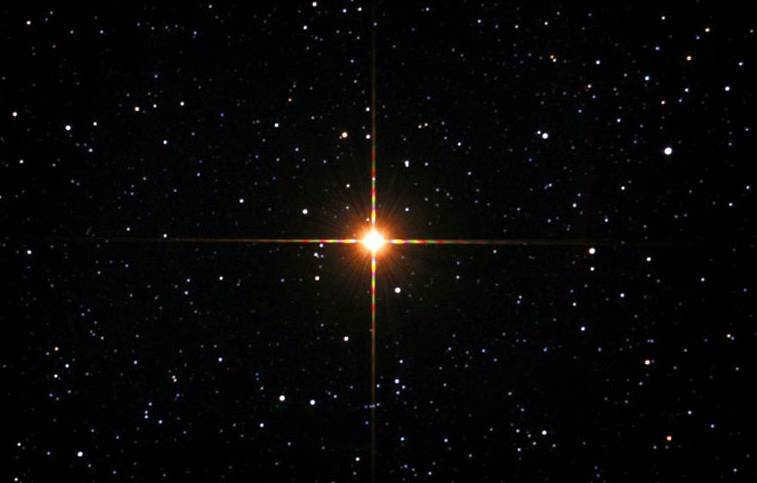
Who among you wouldn’t fantasize about witnessing the monumental departure from the sky of planet Earth of one of the most prominent stars?
An “extremely unpredictable” explosion of a star.
According to certain sources, Betelgeuse, the star forming the right shoulder of the celestial hunter, might at any given moment release its final breath in the form of a long and luminous supernova eruption, leaving behind a void that is invisible to the naked eye.
This occurrence will completely transform the appearance of the constellations that add such beauty to the winter skies in our regions. Should we anticipate this event happening within our lifetime, and is there any danger it poses to our planet?
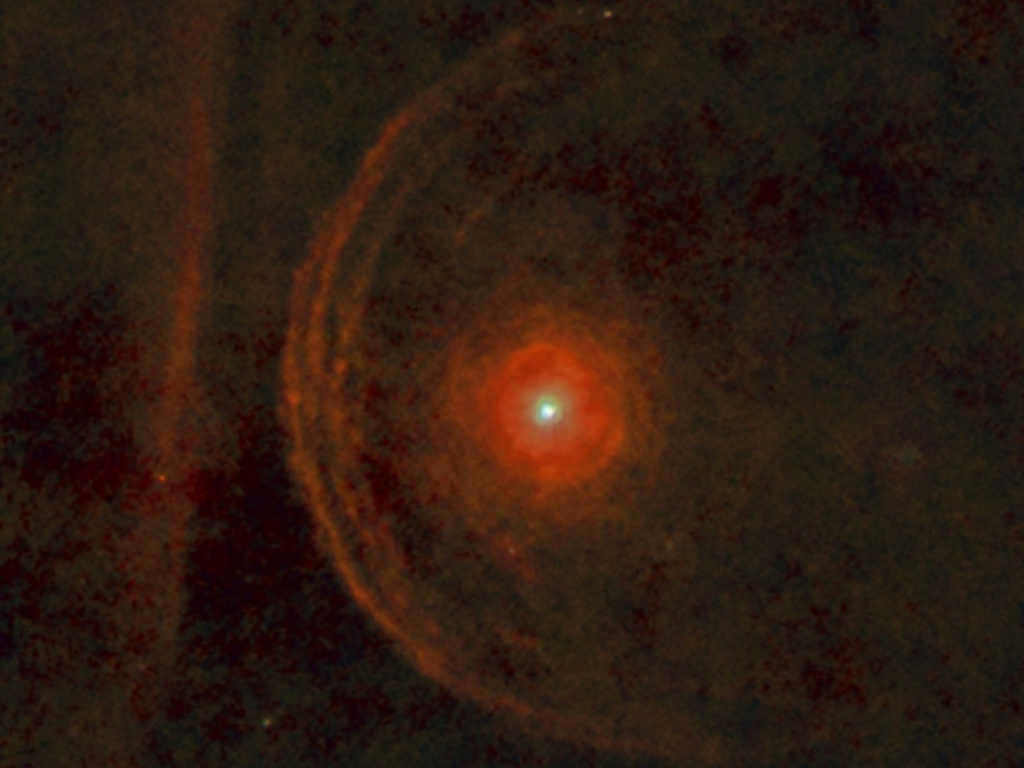
Reports suggest that at any moment, a spectacular supernova explosion could occur. Betelgeuse, a star in the constellation Orion, will dramatically increase its brightness, illuminating the sky for several months. Eventually, it will fade away, leaving behind the Crab Nebula, which is home to a hidden neutron star or black hole at its core. While this cosmic event poses no immediate threat to us, if one of the star’s poles were to be pointed towards Earth, it could cause disruptions to our magnetic field and ozone layer. However, it is important to question the credibility of such reports and consider whether they are simply sensationalized by the media.
Probability of an Explosion
Scientists acknowledge the possibility of such an outcome, although the exact timing and occurrence of an explosion remain unknown. Furthermore, it is uncertain if the celestial body will explode tomorrow, in a million years, or even at all. Despite the advancements in modern astronomy, our understanding of stellar lifespan appears to be in its early stages. The existence of supermassive giants and the challenges in modeling star formation in close systems challenge the established scientific paradigms surrounding the life of stars. The discovery of celestial objects that defy existing theories only generates more questions than answers. Even the well-known Betelgeuse serves as an example of this, as there are still mysteries surrounding it that we have yet to unravel.
The enigmatic Betelgeuse
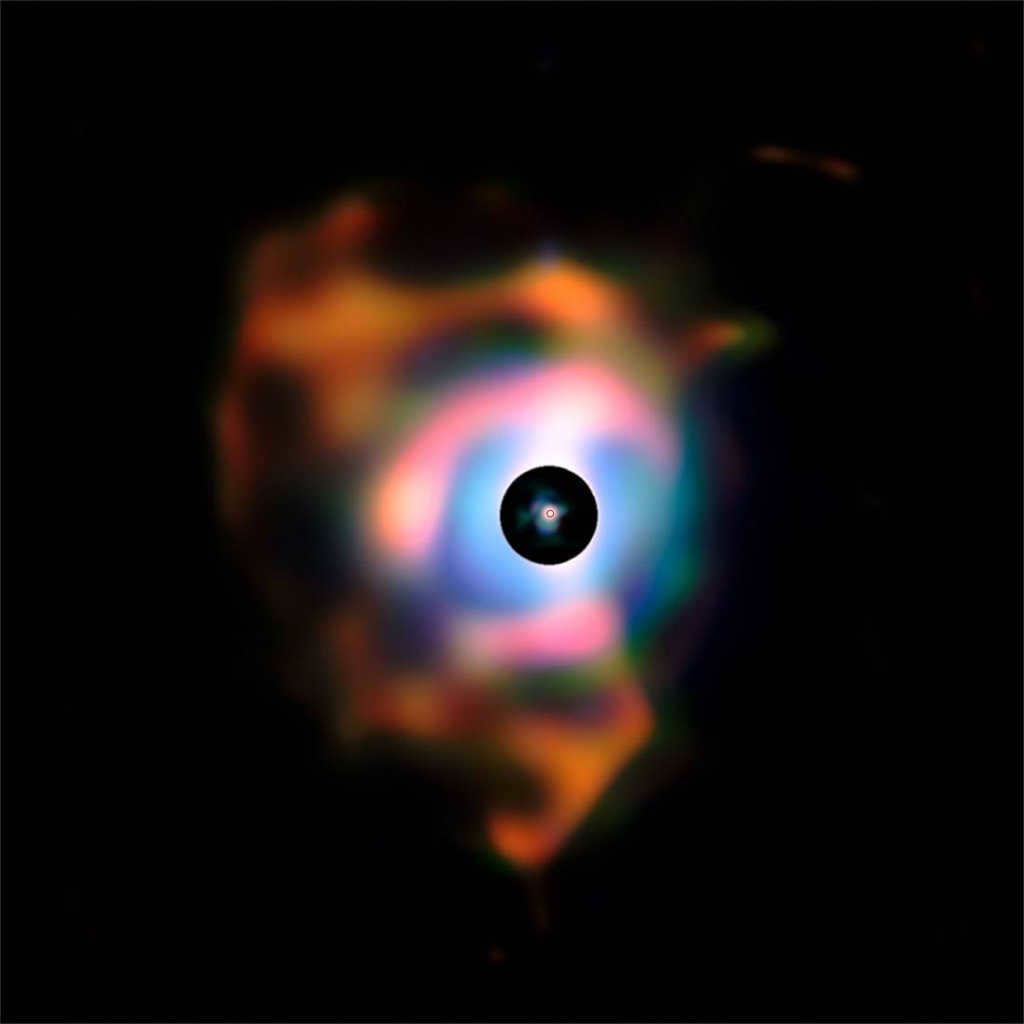
The nebula surrounding the vibrant red giant Betelgeuse.
What do we understand about Betelgeuse? An amateur stargazer casually pointing to the reddish glow will inform you about its immense magnitude, variability, and other publicly accessible information. And, to ignite the listener’s imagination, they might even mention that if you were to replace the Sun with Betelgeuse, all of the planets in the Earth’s group, and maybe even Jupiter, would fit comfortably within the depths of this supergiant. While this may be true, it is interesting to note that a professional astronomer operates with nearly the same set of knowledge about this red giant. For instance, the precise dimensions, mass, and distance to Betelgeuse have yet to be determined.
Scientists have estimated the distance to the star to be approximately 420-650 light-years, although some sources suggest a wider range of 180 to 1300 light-years. The estimates for the mass and radius of the star are also not precise, varying between 13-17 solar masses and 950-1200 solar radii, respectively. These significant discrepancies can be attributed to the challenges of measuring the distance to Betelgeuse, as it is too far away to be measured using the annual parallax method. Additionally, Betelgeuse is not part of a binary star system or a nearby star cluster, which further complicates the accurate determination of its mass and other characteristics, including its absolute luminosity.
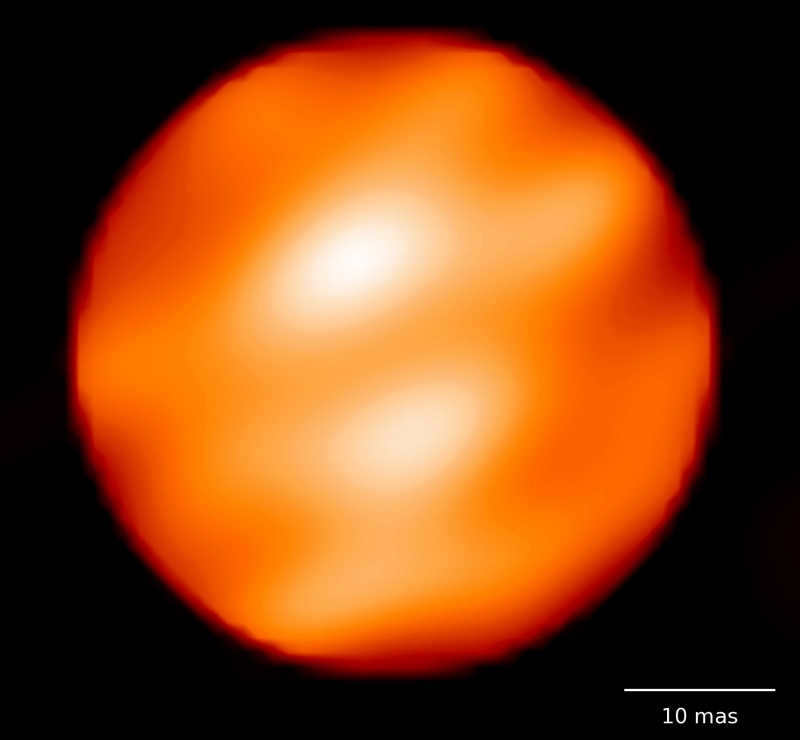
An image captured by the Hubble telescope reveals the disk of the celestial body known as Betelgeuse. This remarkable achievement marked the first time scientists were able to measure the star’s angular size and obtain a clear picture of its disk. However, despite this breakthrough, the image alone does not provide substantial information about the star’s characteristics and nature.
Similarly, the situation is the same when it comes to the entire “stellar” aspect of astronomy. Not only do scientists have to create fresh models that describe the processes of star formation, evolution, and death, but they also have to completely transform the existing ones. For instance, how can we account for the presence of newly found stars with masses ranging from 200 to 250 times that of our sun when the previous theoretical upper limit was only estimated to be 150 solar masses? How can we comprehend the true nature of gamma-ray bursts? There are countless other discoveries waiting to perplex astronomers in the near future.
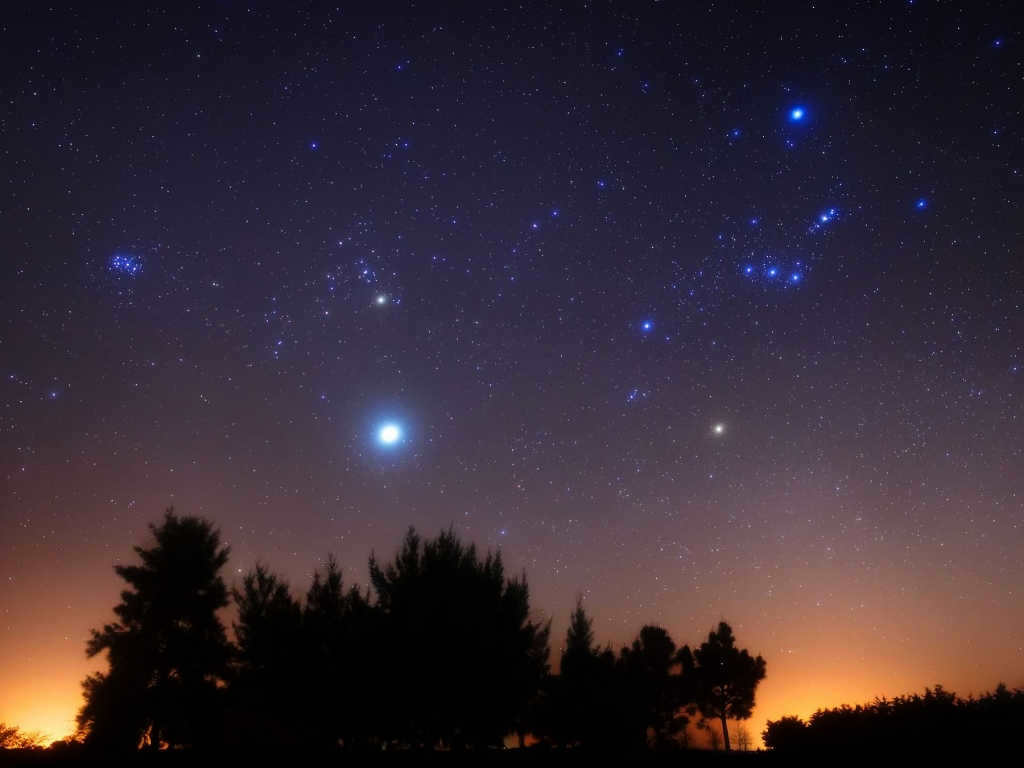
Some of the celestial bodies that can be observed in the night sky include Jupiter, Aldebaran, Betelgeuse, M42, and the Pleiades.
When it comes to Betelgeuse, there have been claims about its imminent appearance as the brightest “farewell fireworks” in our sky. However, astronomers emphasize that while such an event is theoretically possible, the likelihood of it happening is extremely low and cannot be accurately estimated. Nonetheless, the media often sensationalizes these cautious statements in order to generate public interest.
Resources about the subject

Supernova explosions are cosmic events that are observed in reality. There has never been a supernova explosion in science that has been predicted and anticipated in advance. Therefore, astronomers can only indirectly assess the processes that precede the explosion.
Regarding Betelgeuse, scientists confidently state that the star is in its final stage of life, where the current proportion of carbon and subsequent heavy elements can no longer sustain stable thermonuclear processes. According to current models, it is most likely to result in the disruption of the star’s hydrodynamic equilibrium, in other words, a supernova explosion. There is also the possibility that Betelgeuse will end its life less dramatically and simply shed its outer layers, transforming into an oxygen-neon white dwarf.
A dream of cosmic proportions
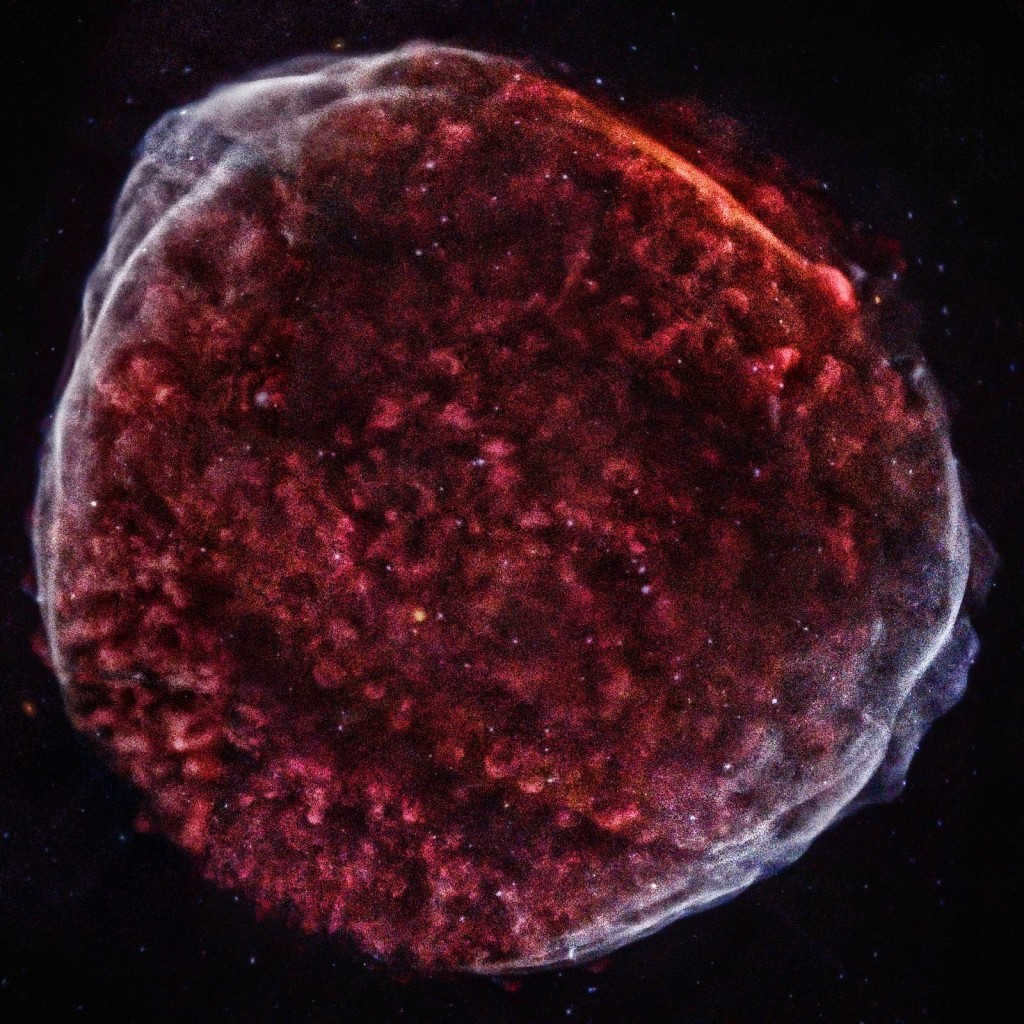
This is the leftover from a Type Ia supernova event.
Undoubtedly, the presence of a dazzling celestial body in the heavens would serve as a catalyst for individuals to momentarily overlook their own insignificance in the vast expanse of the universe. It is truly mind-boggling to consider that the same cataclysmic event could potentially be witnessed by potential inhabitants residing in far-flung systems within our expansive galaxy. However, it is the field of astronomy that stands to gain the most from such momentous cosmic news. With the imminent and highly anticipated supernova explosion occurring within our lifetime, the inquisitive gaze of various telescopes and other scientific apparatus will be fixated upon its trajectory. In a state of frenzied excitement, scientists will diligently populate their databases with an abundance of invaluable data harnessed from the radiant light emitted by the explosion. Daily, information regarding this groundbreaking discovery will be disseminated from all corners of the globe. Yet, it must be acknowledged that these are mere illusions, existing solely within the realm of imagination.
Discover the latest astronomical findings and other current space updates on our website. Join us, bring along your friends, and be the first to catch the most exciting “supernews”!
Index of the most brilliant celestial bodies
NoName
Distance from Earth, light years
Apparent magnitude
Absolute magnitude
Spectral classification
Celestial hemisphere
| 0 | Sun | 0.0000158 | −26.72 | 4.8 | G2V | |
| 1 | Sirius (Alpha of the Big Dog) | 8.6 | −1.46 | 1.4 | A1Vm | Southern |
| 2 | Canopus (Alpha of Kiel) | 310 | −0.72 | −5.53 | A9II | South |
| 3 | Toliman (Alpha Centauri) | 4.3 | −0.27 | 4.06 | G2V+K1V | South |
| 4 | Arcturus (Alpha Volopas) | 34 | −0.04 | −0.3 | K1.5IIIp | North |
| 5 | Vega (Alpha Lyra) | 25 | 0.03 (perm) | 0.6 | A0Va | North |
| 6 | Capella (Alpha Ascendant) | 41 | 0.08 | −0.5 | G6III + G2III | North |
| 7 | Rigel (Beta Orion) | ~870 | 0.12 (perm) | −7 | B8Iae | South |
| 8 | Procyon (Alpha of the Lesser Dog) | 11.4 | 0.38 | 2.6 | F5IV-V | North |
| 9 | Ahernar (Alpha Eridanus) | 69 | 0.46 | −1.3 | B3Vnp | South |
| 10 | Betelgeuse (Alpha Orion) | ~530 | 0.50 (perm) | −5.14 | M2Iab | North |
| 11 | Hadar (Beta Centauri) | ~400 | 0.61 (perm) | −4.4 | B1III | South |
| 12 | Altair (Alpha Eagle) | 16 | 0.77 | 2.3 | A7Vn | North |
| 13 | Acrux (Alpha of the Southern Cross) | ~330 | 0.79 | −4.6 | B0.5Iv + B1Vn | South |
| 14 | Aldebaran (Alpha Taurus) | 60 | 0.85 (rem) | −0.3 | K5III | North |
| 15 | Antares (Alpha Scorpio) | ~610 | 0.96 (perm) | −5.2 | M1.5Iab | South |
| 16 | Spica (Alpha Virgo) | 250 | 0.98 (perm) | −3.2 | B1V | Southern |
| 17 | Pollux (Beta Gemini) | 40 | 1.14 | 0.7 | K0IIIb | Northern |
| 18 | Fomalhaut (Alpha of South Pisces) | 22 | 1.16 | 2.0 | A3Va | Southern |
| 19 | Mimosa (Beta of Southern Cross) | ~290 | 1.25 (perm) | −4.7 | B0.5III | Southern |
| 20 | Deneb (Alpha of the Swan) | ~1550 | 1.25 | −7.2 | A2Ia | Northern |
| 21 | Regulus (Alpha Leo) | 69 | 1.35 | −0.3 | B7Vn | Northern |
| 22 | Adara (Epsilon of the Great Dog) | ~400 | 1.50 | −4.8 | B2II | South |
| 23 | Castor (Alpha Gemini) | 49 | 1.57 | 0.5 | A1V + A2V | Northern |
| 24 | Hakrux (Gamma Southern Cross) | 120 | 1.63 (perm) | −1.2 | M3.5III | South |
| 25 | Shaula (Lambda of Scorpio) | 330 | 1.63 (perm) | −3.5 | B1.5IV | Southern |
This post was published on July 17, 2015
Written by Maxim Zabolotsky
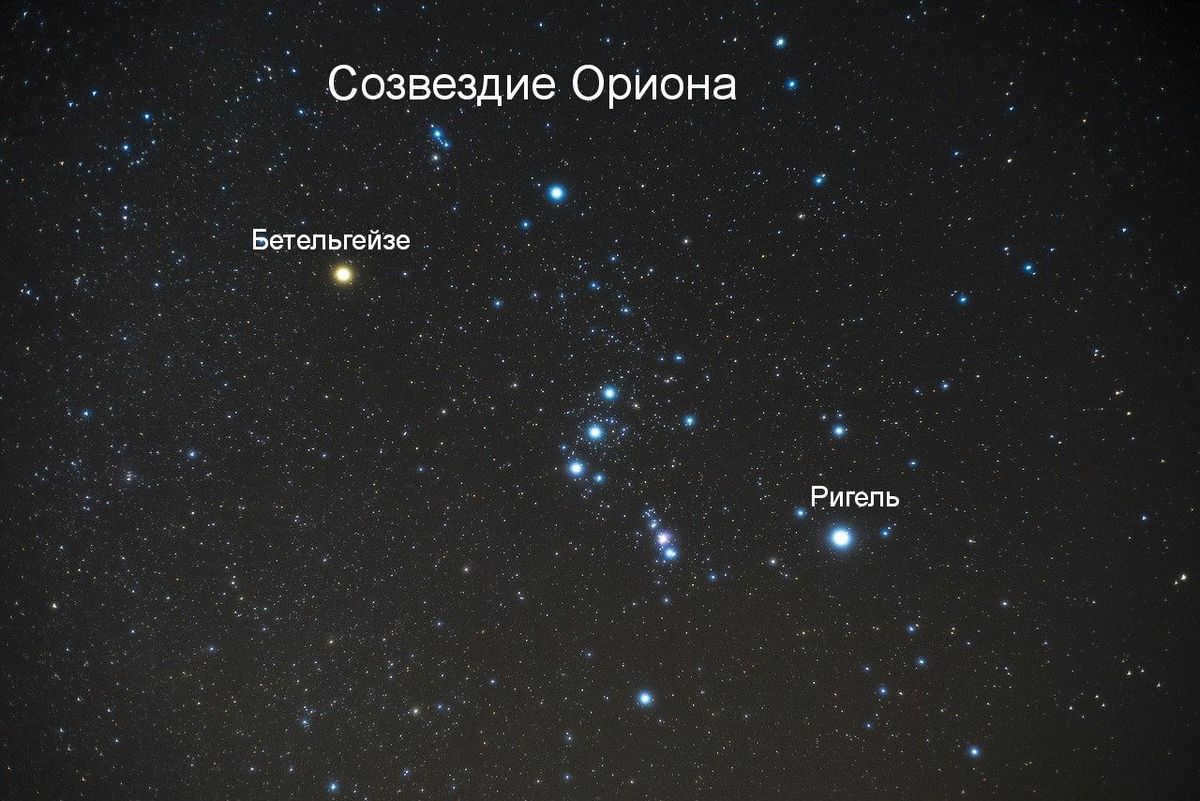
The Betelgeuse star is situated on the shoulder of the Orion constellation. While it may not be the most brilliant star in the constellation, as it falls short to Rigel, it still captivates the attention of astronomers. This is due to the fact that Betelgeuse is nearing the end of its life cycle and has the potential to explode at any given moment. The exact timing of this event remains uncertain, as it could occur tomorrow or even a millennium from now.
This supergiant has been recognized since ancient times and was referred to as the “hand of Gemini” in Arabic. This term originated from Arabic astronomy, which occasionally referred to Orion as Gemini. As of now, Betelgeuse stands as the tenth brightest star on record.
Betelgeuse can be seen from any location on Earth for approximately half of the year, specifically from September to March. During the months of June and July, it is not visible to the naked eye and can only be observed during daylight hours with the assistance of a powerful telescope.
Key Characteristics
- Betelgeuse is a red supergiant that experiences periodic changes in its brightness and size.
- Its radius varies as the star pulsates, ranging from approximately 500 to 800 times the size of our Sun.
- The mass of Betelgeuse is estimated to be around 20 times that of our Sun.
- The volume of Betelgeuse is approximately 300 million times greater than that of the Sun. In fact, Betelgeuse is about 1000 times larger than our Sun. If Betelgeuse were to replace the Sun in our Milky Way galaxy, its size would engulf Earth and Mars, with its orbit extending as far as Jupiter.
- The surface temperature of Betelgeuse is approximately 3600 K.
- It is believed that Betelgeuse is approximately twice as old as our Sun, with an estimated age of 10 billion years.
- The rotation speed around its axis is 15 km/sec, which is higher than that of other red supergiants, possibly due to the absorption of a neighboring star at some point.
- It is moving at a speed of 30 kilometers per second.
- The distance from the Sun is 200 parsecs.
Luminosity
The minimum luminosity is 80,000 times that of the Sun. The maximum level of light emission is 100,000 times greater than that of the Sun. The presence of giant sunspots on Betelgeuse affects its brightness. Additionally, the brightness decreases during the star’s pulsation due to atmospheric instability.
At its peak, Betelgeuse is brighter than Rigel and becomes the 8th brightest star in the sky. At its lowest point, it drops to the 20th brightest.
The most significant decrease in Betelgeuse’s brightness was observed in early 2020, but for a couple of months, the star’s luminosity returned to its previous level. Scientists have not yet determined the true cause of this phenomenon.
Interesting facts about Betelgeuse
1. The star has different names in various cultures, with at least three translations from Arabic: “Al-Zira”, “Al-Manqib”, “Al-Yad al-Yamna”.
2. Betelgeuse’s red glow can be seen with the naked eye.
3. It was one of the first stars to have its angular diameter measured using an interferometer.
4. Betelgeuse is believed to have two of its own satellites.
5. Betelgeuse’s light surpasses that of a nearby gas nebula.





